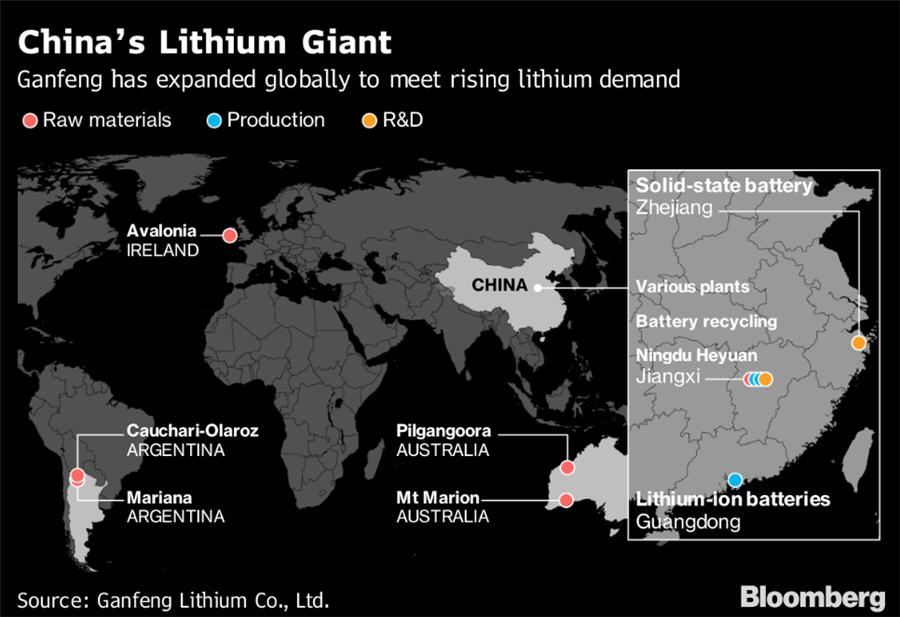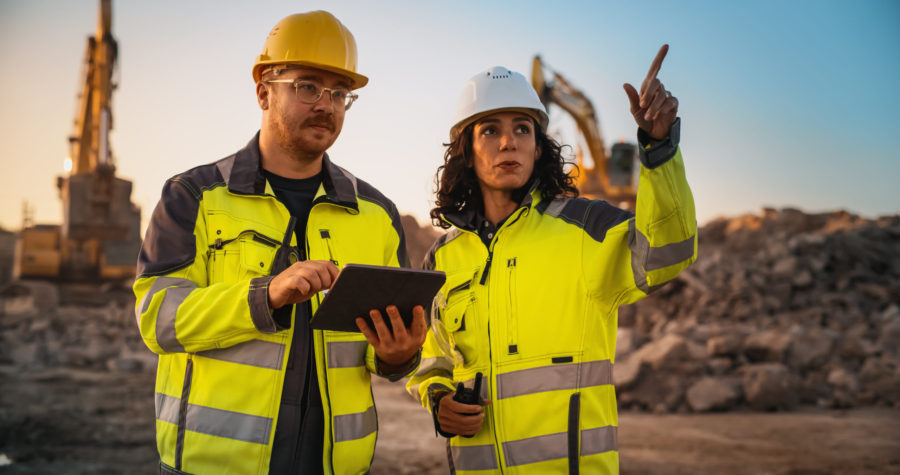The battery boom created a new lithium superpower in china

With a ruined 13th Century castle, the Irish town of Carlow is an unlikely staging post in the super-charged rise of a key player in China’s push to dominate the global electric-vehicle revolution
Gafeng accounts for about a quarter of battery-grade lithium hydroxide, the material that’s now most sought after by automakers
Ganfeng Lithium Co. sent a team to the town — a 90-minute drive southwest of Dublin — in 2013, shuttling between prospective lithium deposits dotted through the verdant countryside. It was part of their company’s first foray outside China amid a drive to boost production of key materials needed to make rechargeable batteries.
With projects and partnerships now spanning South America to Australia, Ganfeng is aiming to use proceeds from a share sale in Hong Kong this week to continue a growth spree that’s forecast to make it the industry’s second-largest producer from this year.
“They understood so many years back — in the early 2000s — that lithium would be driving all of the green energy revolution,” said Kirill Klip, a former executive with Ganfeng’s first overseas partner, International Lithium Corp., who joined the working party in Ireland. “It’s a very hands-on approach, literally — they were working with our geologists turning over rocks, studying all the lithium boulders,” said Klip, now executive chairman of TNR Gold Corp.
Since that Irish expedition, Ganfeng’s share of refined lithium output has jumped from about 6 percent in 2013 to an estimated 11 percent this year, according to Roskill Information Services Ltd.
Formed in 2000 in southeastern Jiangxi province and listed in Shenzhen a decade later, Ganfeng’s expertise has been in processing lithium raw materials — which come typically from South America’s salt lakes or mines in Australia — into the next stage chemical products that can be used in lithium-ion batteries.
Its rapid growth and plans to use its share sale proceeds to lift output further have drawn blue-chip customers anxious to secure long-term supply. Since August, Ganfeng has struck new agreements with Tesla Inc., BMW AG, and battery producer LG Chem Ltd.
“They’ve reacted quickly in a changing market and that’s enabled them to grow their output to market requirements,” Robert Baylis, a London-based analyst with Roskill, said by phone. “Other companies haven’t been able to do that with the same speed.”
That swift growth has been well timed. Fewer than one million EVs had been sold in total at the start of 2016, there are now about four million on the world’s roads and it’ll take only about another six months to add a further million, according to Bloomberg New Energy Finance.
The jump in lithium output has swelled Ganfeng’s earnings — forecast to rise about a third this year — and catapulted the company ahead of established industry leaders such as FMC Corp. in terms of volumes. It’s on course to surpass the second-largest, Chile’s Sociedad Quimica y Minera de Chile SA, this year, according to consultant CRU Group, and is seen eventually challenging the No. 1, Albemarle Corp.
“It’s changed the face of the industry — you had the big three and now you’ve gone to the big five,” said Mike Tamlin, chief operating officer of Neometals Ltd., a partner with Gangfeng and Mineral Resources Ltd., in the Mt. Marion mine in Western Australia. “Arguably the pecking order in the big five has changed” with the expansion of Ganfeng and Tianqi Lithium Corp., he said.
Ganfeng added a stake in Mt. Marion in 2015 and made its first overseas investment in 2011 with Canada’s International Lithium, which remains a partner on prospective development projects in Argentina and the Avalonia venture in Ireland. With Lithium Americas Corp., Ganfeng is aiming to begin production in 2020 at the Cauchari-Olaroz project in Argentina’s northwestern Jujuy province, according to filings.
Still, the company remains disciplined on its growth plans, Vice Chairman Wang Xiaoshen said this week during an interview in Shanghai.
“We lithium suppliers still have to be careful not to over-expand our business, we have to be more conservative,” said Wang. “We want to do things step-by-step, every year see how the market grows, see how the near-term demand grows,” he said.
Recent expansions were announced only once the company had secured long-term supply agreements with customers such as LG Chem and BMW, according to Wang. “So we don’t just dream about big demand coming and then build capacity,” he said, adding that Ganfeng can expand relatively quickly when needed.
While this week’s share sale has attracted cornerstone, investors including battery producers LG Chem and Samsung SDI Co., the listing was priced at the bottom of the expected range, according a statement published Wednesday in the South China Morning Post.
Ganfeng’s shares in Shenzhen dropped as much as 10 percent and competitor Tianqi fell as much as 9 percent. In Australia, Orocobre Ltd. slipped as much as 6.4 percent and Neometals declined 2 percent.
The listing price was “significantly undervalued” as investors were put off by factors such as depressed spot lithium prices, according to Ganfeng’s Wang, who said the company’s priority was to get financing for its near-term projects and that it now wants to move on.
For the longer-term, Ganfeng is positioning itself for opportunities beyond raw materials, including battery production and recycling.
The producer “has always had a very forward-looking approach,” said Andrew Miller, a London-based analyst at Benchmark Mineral Intelligence, an industry consultant. Expansions into recycling and cell production “will be crucial for the company to sustain its growth into the next chapter of battery market developments,” he said.
(By David Stringer and Martin Ritchie)
More News
Rio Tinto, Founders Factory’s Mining Tech Accelerator invests in startups from US and OZ
April 23, 2025 | 04:02 pm
{{ commodity.name }}
{{ post.title }}
{{ post.date }}



Comments